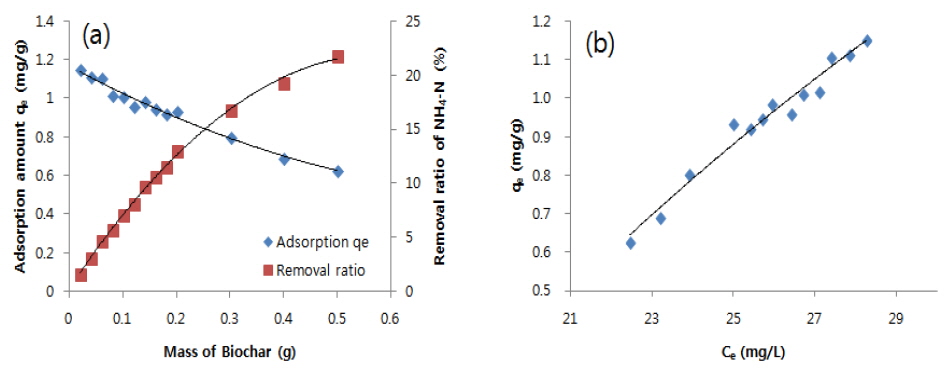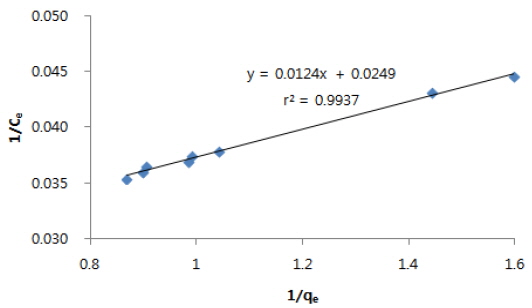



Objective of this study was to investigate adsorption characteristics of NH4-N to biochar produced from rice hull in respective to mitigation of greenhouse gases.
NH4-N concentration was analyzed by UV spectrophotometer. For adsorption experiment of NH4-N to biochar, input amount of biochar was varied from 0.4 to 10 g/L with 30 mg/L NH4-N solution. Its adsorption characteristic was investigated with application of Langmuir isotherm. Adsorption amount and removal rates of NH4-N were decreased at 53.9% and increased at 20.2% with 10 g/L compared to 0.4 g/L, respectively. The sorption of NH4-N to biochar produced from rice hull was fitted well by a Langmuir model. The largest adsorption amount of NH4-N (
It was indicated that biochar produced from rice hull is favorably absorbed NH4-N, because this value lie within 0<
석탄, 석유, 천연가스 등의 연료로부터 발생하는 온실 가스(greenhouse gases, GHG)는 온실 효과(greenhouse effect)에 큰 영향을 미치는 것으로 나타났다(Lehmann, 2007). 농업 및 토지 이용에서 발생하는 온실 가스, 특히 이산화탄소(CO2)는 총 발생하는 온실 가스의 20% 정도 차지하고 있다고 추정되고 있고 또한, 기후 변화에 따른 작물 생산성에 대한 직・간접적인 효과에 관한 연구도 발표되었다(Koocheki and Nassiri, 2008).
아산화질소(N2O)는 지구온난화지수(global warming potential, GWP)가 이산화탄소보다 298배 더 크며(IPCC, 2007), 대기 중의 아산화질소 농도는 매년 0.8% 증가하고 있다(IPCC, 1994). 지구 온난화에 큰 영향을 미치고 있는 아산화질소는 질소 순환 과정 중 탈질화작용(denitrification) 과정에서 생성되고(Davidson
이러한 아산화질소의 배출을 억제하기 위한 방법으로 바이오차(biochar)가 주목을 받고 있다. 바이오차는 열분해(pyrolysis) 및 액화 공정(liquefaction technology)을 통하여 바이오 오일을 만드는 과정에서 발생하는 부산물로써, 흡착제로 사용되고 있다(Arami-Niya
바이오차의 흡착 특성을 설명하기 위해 많은 실험이 수행되었으며, 바이오차의 소재로 밀짚, 옥수수대, 땅콩 껍질을 온도별로 제조하여 NH4-N와 NO3-N의 흡착 특성을 알아보는 연구 결과, NH4-N 흡착량은 높은 온도(700℃)에서 생성된 바이오차보다 낮은 온도(400℃) 일 때 밀짚, 옥수수 대, 땅콩 껍질에서 각각 36%, 46%, 38% 정도 흡착량이 더 높게 나타났지만, NO3-N에 대해서는 오히려 용출되는 현상이 일어났다고 보고한 바 있다(Gai
따라서 본 연구는 기후 변화에 영향을 미치는 온실가스인 아산화질소 배출을 감소시키기 위한 방법으로 왕겨를 소재로하여 제조한 바이오차의 NH4-N의 흡착 특성을 규명하는 것이었다.
실험재료로 사용한 바이오차는 지역 단위 협동조합에서 왕겨를 소재로 하여 만든 제품을 구매하여 이용하였다. 바이오차의 입자크기는 체(sieve)를 이용하여 0.5 mm 에서 2 mm 사이로 걸러 사용하였으며, 왕겨 바이오차의 화학적 특성은 Table 1에 나타내었다.
[Table 1.] Characteristics of biochar from rice hull used in this study

Characteristics of biochar from rice hull used in this study
pH와 EC(electrical conductivity)는 바이오차 5 g을 플라스틱 병에 넣은 후 증류수 100 mL(1:20)를 가하여 회전식 진탕기(SJ-801S, Neuronfit, Seoul, Korea)에서 160 rpm으로 30분간 진탕한 후, pH/EC meter(Orion 4 star, Thermo scientific, Waltham, USA)로 측정하였다. TC(total carbon), TOC(total organic carbon) 및 TIC(total inorganic carbon)는 950℃에서 WO3를 촉매로 사용하는 유기탄소분석기(Elementar Vario EL II, Hanau, Germany)를 이용하여 분석하였다. TOC 분석은 2 M HCl을 이용하여 inorganic carbon을 완전히 제거하고 건조 시킨 후 유기탄소분석기를 이용하여 측정하였다. NH4-N 용액은 (NH4)2SO4 (Guaranteed Reagent, Junsei, Tokyo, Japan)로 제조하였고, NH4-N 분석은 EPA Method 350.2에 따라 UV spectrophotometer 측정용 키트(ST- Ammonium, C-Mac, Deajeon, Korea)로 655 nm에서 측정하였다.
>
왕겨 바이오차 투입량 변화에 따른 NH4-N의 흡착량 및 제거율 산정
왕겨 바이오차의 NH4-N의 흡착량과 제거율을 산정하기 위하여 NH4-N 농도를 30 mg/L으로 고정시키고 바이오차를 0.4-10 g/L의 범위로 변화시키는 조건으로 실험을 수행하였다. 각각의 플라스틱 병에 바이오차 투입량을 넣고 30 mg/L NH4-N 용액을 주입한 후 왕복식 항온 진탕기(JP/NTS-3000, Eyela, Tokyo, Japan)를 이용하여 25℃에서 140 rpm으로 24시간 교반 후 여과하였다. 이때, 바이오차의 입자크기를 0.5 mm-2 mm로 하였기 때문에 Whatman No.2를 이용하여 여과하였다. 이 침출액의 NH4-N 성분을 분석하여 왕겨 바이오차에 대한 NH4-N의 흡착량 및 제거율을 산정하였다.
NH4-N의 흡착량과 제거율은 교반이 완료된 후 용액 중에 잔류하는 NH4-N의 농도를 측정하고 Eq. 1와 Eq. 2를 이용하여 구했다.
Eq. 1와 Eq. 2에서
Langmuir 흡착등온식은 Eq. 1을 이용하여 계산한 NH4-N 흡착량(
Eq. 3에서
Eq. 4에서 1/
Langmuir 흡착등온식의 특징은 Eq. 5로 정의되는 무차원 상수
[Table 2.] Type of langmuir isotherm based on dimensionless constant (RL)

Type of langmuir isotherm based on dimensionless constant (RL)
왕겨 바이오차 투입량에 따른 NH4-N의 흡착량 및 제거율을 조사한 결과는 Fig. 1(A)로 나타냈다. NH4-N 용액의 농도를 30 mg/L으로 고정시키고 바이오차를 0.4-10 g/L 수준으로 나누어 실험한 결과 NH4-N 흡착량은 1.15-0.62 mg/g 로 지수 함수적으로 감소하는 경향을 보였다.
반면에, NH4-N 제거율은 1.6-21.8%로, 0.2 g까지는 직선에 가까운 선형적 관계를 보였지만 0.3 g 이상부터는 바이오차 투입량에 따른 흡착 제거율이 곡선의 형태를 보여줌으로써 전체적으로 로그 함수적으로 증가하는 경향을 보였다. 이는 바이오차 투입량이 증가함에 따라 흡착층의 중첩현상 때문에 바이오차의 활성 사이트를 보호하는 현상이 일어나고 (Kizito
왕겨 바이오차의 NH4-N 흡착능력을 조사하기 위해 Langmuir 흡착등온식에 적용하였으며, Langmuir 흡착등온식에서 도출된 직선식은 Fig. 2에 함께 표시하였다. 이 직선식을 Eq. 4에 대입하여 기울기와 절편으로부터
[Table 3.] Parameters calculated from langmuir isotherm model

Parameters calculated from langmuir isotherm model
무차원 상수
다른 소재를 이용하여 제조된 바이오차로 수행된 연구를 보면, 견목을 소재로 하여 300℃에서 8-12시간 열분해한 바이오차를 NH4-N 용액과 낙농 분뇨 폐수에 첨가한 후 최대 흡착량을 산출한 결과 NH4-N 용액과 낙농 분뇨 폐수에서 각각 2.8 mg/g, 8.3 mg/g을 흡착하였으며(Sarkhot
바이오차의 흡착 mechanism을 보면 Fig. 3에서 보는 바와 같이 바이오차에 흡착된 암모니아(Ammonia)는 다양한 형태로 존재하며(Boehm, 1994), 암모니아는 바이오차 표면에 존재하는 산소 그룹과 반응하여 아민(Amines) 또는 아미드(Amides)를 형성한다고 알려져 있다(Seredych and Bandosz, 2007). 암모니아는 Brownsted and/or Lewis acid로써 반응하여 바이오차 표면에 존재하는 카르복실기(Carboxyl group)와 반응한 다음, 암모늄염(Ammonium salt) 또는 아미드(Amide)를 형성한다(Fig. 3).
본 연구의 결과는 앞서 선행된 연구와 비교하였을 때 보다 낮은 흡착량이 산출되었다. 이는 앞서 선행된 연구와 다른 바이오차 소재를 사용하였고, 바이오차를 생성하기 위한 온도와 시간이 다르기 때문에 바이오차의 흡착 능력에 차이가 나는 것으로 판단된다. 또한, 교반 시 교반 조건으로 설정한 온도, 속도, 시간 역시 바이오차 흡착 능력에 영향을 미칠 것이라고 판단된다. 선행 연구에서는 바이오차의 투입량을 고정시키고 NH4-N 용액의 농도를 변화시키는 조건에서 실행되었지만 본 연구는 농경지에 바이오차를 시용한다는 전제 조건하에 바이오차의 투입량을 변화시키고 NH4-N 용액의 농도를 고정시키는 조건에서 수행하였다. 따라서 앞서 선행된 연구 결과와 본 연구의 연구 결과를 상호 비교하는 것은 바람직하지 않다고 판단된다.










